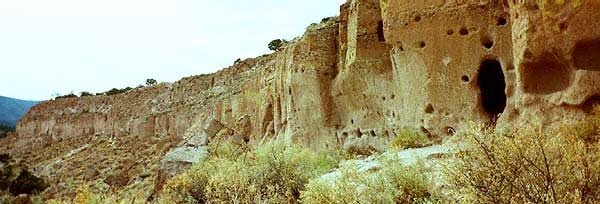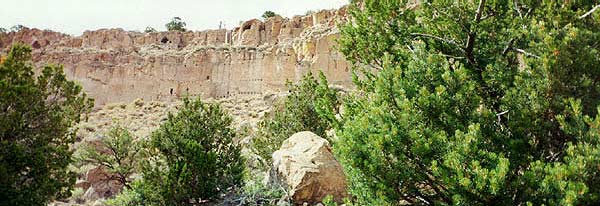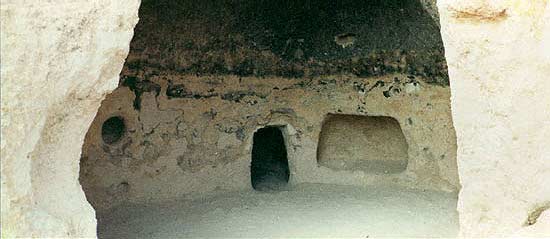

For more than three centuries - about A.D. 1250 to 1577 - this spectacular locale was home for over 1500 Pueblo Indians who built villages, dwelled, farmed, and hunted game here. The traditions of the people of the Pueblo of Santa Clara (located 10 miles east of Puye) state that their ancestors were the inhabitants of this area. They left when drought caused springs to dry up and crops to fail.
In the Tewa language, the name Puye translates as "pueblo ruin where the rabbits assemble or meet." Puye Cliff Dwellings is a National Landmark and is owned and operated as a cultural monument by the Pueblo of Santa Clara.
There are two separate self-guided tours available.
Please do not climb or walk on the walls of the ruins. Keep the trails clean for the next visitor. Do not litter. If you see trash on the ground, please pick it up and deposit it in a trash can.
With admission to the Santa Clara Indian Reservation, including the Puye Cliff Dwellings, the visitor hereby releases the Santa Clara Pueblo and holds them harmless from any and all liability that may arise in connection with any and all forms of accidents or mishaps, whether naturally caused or otherwise, that may occur while visiting the reservation and its environs.
A little over a million years ago an enormous volcano, the Jemez Caldera, erupted and spewed out huge masses of lava and ash that formed the successive layers of black basalt and volcanic tuff (rock formed of compressed volcanic ash and cinders) of the Jemez Mountains. Since that time, erosion by rain, snow, wind and cycles of freezing and thawing have carved through the tuff to form the sheer cliffs that border the canyons which drain the mountains.
Weathering of the surface of the tuff cliffs leads to the development of a somewhat hard surface layer. This is easily broken through, and the underlying tuff is soft and crumbly. This tuff can be dug away using stone or even wood tools - tools easily available to the prehistoric occupants of these dwellings. All of the rooms would have had level floors of well smoothed adobe clay. The deep channels seen in the floors of some of the rooms have been formed by the feet of the thousands of visitors to these ruins in the last 100 years.
These rooms dug into the cliff wall extend for over a mile along the south face of the Puye mesa, sometimes at two separate levels.

Along the cliff wall, above the cave rooms, can be seen holes carved into the cliff. These large, circular holes were used to place and support logs used as roof beams for the buildings built from talus blocks on the front of the cliff wall. On these walls are also seen petroglyphs carved into the rock by artists standing on the upper floors and roofs of the talus buildings. Figures found among the petroglyphs here are concentric circles, spirals, animal forms, human figures, masks and a horned or plumed serpent. These clues tells us that the rooms carved into the cliff walls were just the back rooms of the dwellings built along the face of the cliff.
The ceilings of most of the rooms carved into the cliff show the marks of the sticks used to carve away the soft tuff rock. Smoky fires, used for heat and light, caused soot to accumulate on the walls and ceilings, often indicating that the upper part of the room was frequently filled with smoke. Floor vents were built to bring fresh air into the rooms, and ceiling vents helped to disperse the smoke. Prolonged use of the rooms would certainly not have been healthy.

Fractures in the tuff bedrock allow water from rain and melting snow to percolate into the cave-like rooms. The freezing of this water, which causes it to expand, exerts pressure on the rock, causing sections of the cliffs to collapse, particularily in regions where the cliff face has been weakened by the digging of these rooms. Lives may have been lost in this way, perhaps often enough to cause the Indians to abandon this site entirely.
Over a dozen stairways link the great Community House on the mesa top to the talus and cave rooms and the land below. Stairs lead downward in various directions, including many to the north, toward Santa Clara Canyon and water. These stairways are not formal steps, but are convenient stepping places that have been intentionally cut and further worn into the cliffs. They are often accompanied by finger grips to make climbing the stairs easier.
At least two subterranean ceremonial chambers - kivas - have been found in the talus areas at the base of the cliffs. Large sockets have been cut into the cliff to hold the heavy roof beams needed to span such a large room.
On the top of the mesa the Community House was constructed of shaped blocks of volcanic tuff, quarried from the edges of the mesa top. With its enclosed plaza, it may have served a somewhat defensive function, though the broad passage at the southeast corner would seem to negate this. Information obtained at the time of the excavation indicates that portions of the structure were two or three stories high. Entrances to rooms from ground or roof level may have been via a ladder, with room to room correspondences as well.
Pueblos are very often compared to modern apartment houses. That comparison is appropriate at Puye.
Beginning in the late 1100s, the upland mesas flanking the east side of the Jemez Mountains were settled by people of the Anasazi Culture. At first there were hundreds of individual, family size dwellings. By A.D. 1300, the people were converging in relatively few principal villages which grew to considerable size. Such villages include Puye, Tsankawi, Tyuonyi, Otowi, Shufinne, and Tsirege. The latter village, Tsirege, means "little bird" in the Tewa language. Archaelogist Edgar L. Hewett adopted the name, but translated it into Spanish - Pajarito - and applied it as a general name for the great area of prehistoric settlement around the eastern flanks of the Jemex Mountains, thus the Pajarito Plateau.
Approximately 1440 people lived here.
The site was excavated in 1907.
The inhabitants spoke Tewa, the current language of most of the northern pueblos in New Mexico.
The source of livlihood for most of the inhabitants was farming.
Puye was first inhabited in the late 1100s.
It was finally abandoned about 1580.
Santa Clara Pueblo
An aerial view of the Puye Cliff Dwellings from the National Aerial Photography Program of the USGS is available. The sinuous white structure seen in the photograph is the exposed ridge of tuff along which the dwellings were built. The cleared region on top of the ridge where the larger structures were constructed can also be seen.